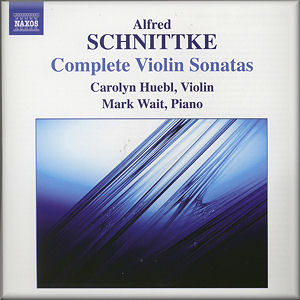 |
 |
|


alternatively
CD: MDT
AmazonUK
AmazonUS
Sound
Samples & Downloads |
Alfred SCHNITTKE (1934-1998)
Complete Violin Sonatas
Sonata for Violin and Piano No. 1 (1963) [17:01]
Sonata for Violin and Piano No. 2 Quasi una Sonata (1968/1987)
[22:37]
Sonata for Violin and Piano No. 3 (1994) [14:51]
Sonata 1955 for Violin and Piano [14:51]
 Carolyn Huebl (violin); Mark Wait (piano)
Carolyn Huebl (violin); Mark Wait (piano)
rec.1-4 June and 25-26 September, 2009, Ingram Hall, Blair School
of Music, Vanderbilt University, Nashville, Tennessee, USA. DDD
 NAXOS 8.570978 [69:20]
NAXOS 8.570978 [69:20] 
|
|
|
Schnittke's intensity, focus and inward-directed heat are ideally
suited to chamber music. Concentration, minimal consonance,
the timbres of individual instruments together with their textures
when sounded harmonically create a fertile world. There the
wry and self-confident Russian melodies that Schnittke introduces,
almost behind your back, can grow, strengthen and affect you.
Carolyn Huebl and Mark Wait, both from Vanderbilt University,
Nashville, here present all three of the composer's numbered
sonatas for violin and piano along with the earliest one from
1955. They have the characteristics of great reflection, tightness,
economy, though of a restrained and bare lyricism; of variety
and a mix of moods from the sombre to the almost jaunty and
jazzily lighthearted (the fourth movement of No. 1 [tr.4], for
example). Indeed, together with the pair's extreme technical
yet unobtrusive virtuosity, this faculty of being at home in
all Schnittke's many idioms is one of this excellent CD's strongest
points.
Equally remarkable is the extent to which Huebl throws herself
into the essence of Schnittke's string writing. Almost all of
his violin sonata writing was directly inspired by the work
- and hence the style - of Mark Lubotsky and Gidon Kremer with
their acerbic and understated tautness. To Wait's unretiring
yet sensitive pianism, Huebl brings an equally demonstrative
certainty. She never over-layers Schnittke's sonorities; they
are designed to be as spare in sound as his themes are meant
to prick rather than caress.
The Sonata No. 1 dates from 1963; it was in the following year
that Lubotsky gave the première. It makes use of serial techniques
and is generally springily experimental. Significant among its
characteristics - and equally well brought out by these two
fine soloists - is the relationship between piano and violin:
prompting, antagonising, supporting, echoing and so on. Huebl
and Wait explore these seamlessly and add to the momentum of
the sonata greatly by respecting Schnittke's conception of the
duality of these two instruments.
Sonata for Violin and Piano No. 2 Quasi una Sonata was
written just five years later, in 1968. The longest single work
on the CD at nearly 23 minutes, it's one of the composer's best
well-known and most often performed pieces with much more angularity
- anger even - than the others here. Yet, again, Huebl and Wait
have rightly preferred to accentuate the music's essence over
its surface. There are the glissandi, mordent harmonics
and wistful rhythmic ambiguities - all characteristic of Schnittke.
We also hear the gestures that may or may not be quotations
- they're certainly evocative - and the dissonant intervals
and repetitive chords - famously those for piano toward the
end of the piece. The players here are full of life, not labour:
very pleasing performances. They evoke the emotion, they don't
'demonstrate' it.
Lubotsky's and Schnittke's collaboration was renewed with the
Third Sonata, which dates from thirty years later. It’s more
spare and darker still. The two players here also capture Schnittke's
austerity though again without overplaying it. Schnittke - paradoxically
- more implies than exposes such sparseness with regard to thematic
development and instrumental sound. In keeping with what we
know of Schnittke's health at this time - his two strokes in
the 1980s were of major concern - there is little real joy or
exuberance for all the music's insistence and confidence. Both
Huebl and Wait, though the former in particular, have an expert
and effective tread when conveying something balanced finely
between resignation and regret. This can be heard in the halting
fourth movement, for example [tr. 9]. This is tellingly marked
as senza tempo, which literally means that there is no
tempo marking; but also suggests time running out.
The Sonata 1955 for Violin and Piano also lasts just
under 15 minutes but is from a different world, written forty
years earlier. In places it could be by one of the English pastororalists
of that generation. There is even a passage sounding like a
Scottish jig near the start. The challenge for Huebl and Wait
was not to treat it as an immature or incomplete piece. They
succeed very well. Each aspect of musical interest - instrumental
articulations, rhythmic particularities, cross-references -
is given its due weight. This is Schnittke, but not the one
we first think of; perhaps that's why it's placed at the end
of the recital.
There is a handful of recordings of these four works individually.
But none in the current catalogue which nicely groups all three
as this one does. That alone makes it a good choice. The acoustic
is clean and close. The notes with the booklet are illuminating.
All in all a sympathetic, revealing and enduring set of performances
that can only enhance Schnittke's reputation. Don't hesitate.
Mark Sealey
|
|

